by Sam Nickerson: Recent studies have examined the link between exposure to nature and health…
but do some of these landscapes do a better job at boosting your health than others?
A new study out of the University of Wollongong in Australia found that public green spaces covered by some kind of tree canopy, as opposed to bare grass or low-lying vegetation, provide the greatest health benefit.
Published this week in JAMA Network Open, the study found that adults living in a neighborhood with at least 30 percent tree cover were 31 percent less likely to develop psychological distress and 33 percent less likely to have fair or poor health overall.
“Our findings suggest that urban greening strategies with a remit for supporting community mental health should prioritize the protection and restoration of urban tree canopy,” authors Thomas Astell-Burt and Xiaoqi Feng wrote. “In addition, the promotion of equal access to tree canopy may provide greater equity in mental health.”
The results support previous research into “forest bathing” therapy, which has been linked with lower stress, blood pressure and anxiety.
The researchers monitored the health of nearly 47,000 Australian adults living among three distinct types of green space: tree canopy, plain grassy areas and low-lying vegetation. The participants were surveyed about which landscape they lived near as well as their mental and general health. The researchers followed up with a second survey six years later.
Participants were asked to self-report whether they had recently felt different measures of psychological distress and the researchers used satellite data to track the percentage of green space near each participant. The result was that “total green space appeared to be more associated with lower odds of incident psychological distress,” but there were some caveats.
Living near low-lying vegetation did not appear to be strongly associated with either positive or negative health, but being exposed to 30 percent or more grass yielded 71 percent higher odds of reporting psychological distress, even after accounting for socioeconomic factors and age or sex.
The researchers cited past studies showing that adults aren’t as likely to wander in plain green spaces without many features, and suggested that large swathes of grass without tree cover may actually make for more sprawling cities.
Without trees to provide shade and reduce temperatures, people may choose to drive short distances instead of cutting through the park or walking on a hot sidewalk. The researchers suggested this may also impact social interactions. Moreover, tree-covered areas provide more biodiversity and mental stimulation, which has been linked with better psychological health.
“Green spaces with tree canopy are settings where communities can come together to watch birds and other animals, which can also be catalysts for new conversations and developing feelings of community belonging in the neighbourhoods where we live … just ask dog owners,” Astell-Burt and Feng wrote in The Conversation.
In another recent study by University of Washington and Stanford University, researchers examined how to effectively incorporate findings like these into city planning policies.
“Thinking about the direct mental health benefits that nature contact provides is important to take into account when planning how to conserve nature and integrate it into our cities,” said lead author Greg Bratman of the University of Washington.




















































